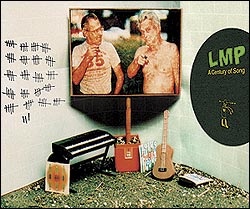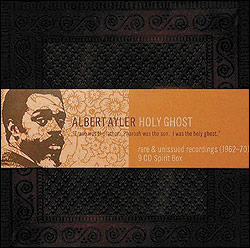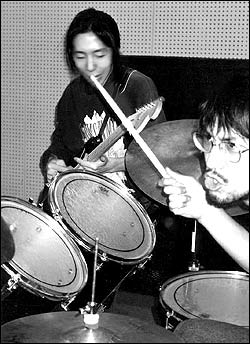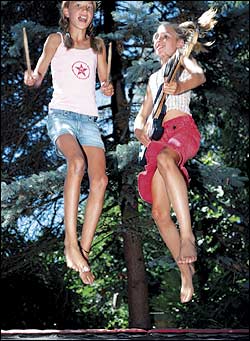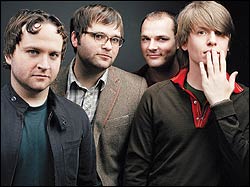Eric Haugen and Ryan Bassler, the Evanston, Ill., duo who call themselves LMP (for La Musique Populaire) had a huge, clever idea in 1999, and it took them five years to pull it off, but they’ve finally done it. A Century of Song (on their own Polyholiday Records, www.polyholiday.com) presents their covers of songs written every year between 1900 and 2001, in a homemade six-CD box set. Really homemade: The pages of the 130-page booklet that comes with it appear to have been cut out by hand. (You can also download an eight-minute “megamix” of the box, included on disc six, from the Polyholiday Web site.)
Haugen and Bassler aren’t the only people to have had that particular idea, as it turns out: The Holy Modal Rounders’ Peter Stampfel has also been recording a song from every year of the 20th century (and presented some of them at last year’s Experience Music Project Pop Conference). But LMP are considerably less reverent with their source material than Stampfel tends to be, which is saying something. The first song they recorded for A Century of Song, 1958’s “Yakety Yak,” is delivered in a merciless Bob Dylan impression; 1914’s “St. Louis Blues” gets a year-appropriate verse about “the workers’ revolt” that I’m pretty sure wasn’t in the original. A few of LMP’s selections were incontestably huge hits in their day (“You Are My Sunshine,” “We Built This City”), but they tend to go for left-field choices, almost to the point of perversity—1962 is represented by Hayley Mills’ “Cranberry Bog,” 1998 by Boards of Canada’s “Aquarius.”
They’ve got a century’s worth of genres to play around with, too—almost no song is recorded in the style with which it was originally associated. A churchy chorale intones Metallica’s 1991 “Nothing Else Matters”; the 1916 novelty “Where Did Robinson Crusoe Go With Friday on Saturday Night?” turns into an extended disco jam; 1901’s “She’s Getting Mo’ Like the White Folks Every Day” is presented in a style LMP describe, accurately, as “Goodbye Cruel World–era Elvis Costello.”
As you might guess, a lot of Century is pretty funny. The best joke in the set is “Hits of ’69,” a breathless disco medley in the “Stars on 45” vein. It starts innocuously enough, with “Sugar Sugar” and a couple of Creedence hits; by the time it ends, almost 10 minutes later, it’s encompassed 23 increasingly unlikely songs, including the Beatles’ “The Ballad of John and Yoko,” John Lennon and Yoko Ono’s “John and Yoko” (from The Wedding Album, in which John and Yoko simply repeat each other’s names), Frank Zappa’s “Peaches En Regalia,” and Pharoah Sanders’ avant-jazz landmark “The Creator Has a Master Plan” (for which Bassler imitates Leon Thomas’ yodel with uilleann pipes). There’s some even weirder stuff hiding on a bonus disc of rough versions, outtakes, and unused fragments from the Century project’s sessions. (Haugen invents a mercifully abandoned lyric for their version of 1972’s instrumental “Theme From Deep Throat“: “Deep, deep, deep throat/You’ve got a clitoris in your throat.”)
Still, the Century of Song tracks that work best are the ones executed mostly in earnest: 1902’s “Bill Bailey, Won’t You Please Come Home?” as a baggy-panted Manchester-circa-1989 groove; 1925’s “Sweet Georgia Brown” arranged à la Parliament; and versions of the Shirelles’ 1960 “Will You Love Me Tomorrow,” Caetano Veloso’s 1971 “Maria Bethânia,” and the Left Banke’s 1967 “She May Call You Up Tonight” done in the style of . . . well, actually, LMP themselves—high-detailed, low-tech power pop. (They’ve also made a bunch of records of their own stuff, and 2000 and 2001 are represented on the box by original songs: “A Century of Song” and “Does Anyone Remember a Century of Song?”)
There’s a real change in Century‘s material that appears around 1938, and it’s reflected in the way we talk about the songs. That’s when the shift from sheet music to recordings as the main way songs were disseminated came about, and it’s when Century‘s songs stop being generally of their era and start being associated with particular performers. (People think of 1937’s “Let’s Call the Whole Thing Off” as being by the Gershwins, not by a singer; 1938’s “Back in the Saddle Again” belongs to Gene Autry rather than its co-writer, Ray Whitley; and 1939’s “We’ll Meet Again” is effectively a Vera Lynn song, not a Ross Parker & Hughie Charles song.)
That change also effectively crippled the amateur music tradition—the idea that people could gather around a piano and sing “K-K-K-Katy” or “Look for the Silver Lining” for fun, without thinking even for a moment about a standard version against which theirs might fall short; that music was something people did in their homes, with friends. A Century of Song, though, is an amateur project all the way, in the best sense. LMP recorded most of it in a basement studio, on the cheap, with some instruments they could play and others they could . . . sort of play. What they don’t have in slickness and grace, they make up for with inventive, complicated arrangements that make the most of whatever they’ve got on hand—especially their voices. (Their backing vocals suggest classic pop-radio splendor whether or not they hit the notes.) And one of the joys of Century is that so much of it involves guest singers and musicians, most of whom are as intently casual about their performances as Bassler and Haugen. It sounds like everyone’s having a great time. How many box sets can you say that about?
